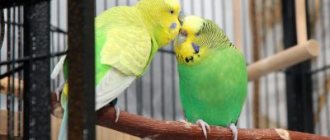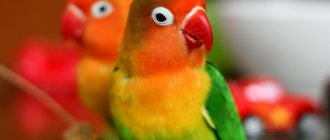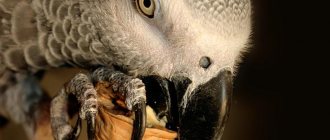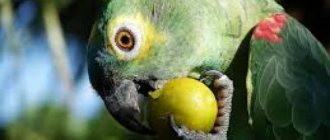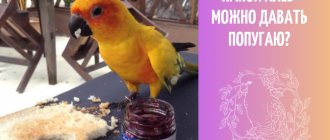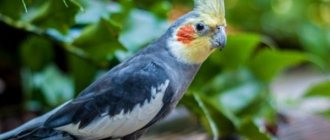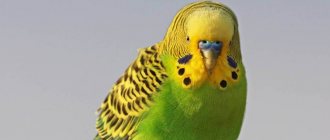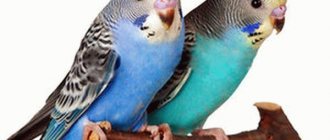Funny singing lovebirds have earned an excellent reputation as unobtrusive, pleasant and charming pets. These are clean, neat birds, small - up to 15 cm from head to tip of tail. Experts in breeding parrots recommend keeping these feathered pets in pairs; the name of the bird itself hints at the same feature. However, many people are interested in whether it is possible to keep one lovebird and whether this will affect its quality and life expectancy.
If you bought one lovebird
Didn't succumb to the seller's statements at the pet store and bought a bird? They brought her home, and then her conscience awoke. Gnawing at the acquisition, bad thoughts creep into my head. Is the parrot destined to die because he was separated from his mate?
All this is nonsense. You can keep a lovebird alone. He needs to pay more attention than when parrots live in pairs. They keep themselves busy and have no time to be bored.
Lovebirds are social birds. They have a very developed need for communication. Birds are smart and willing to make contact. There shouldn't be any problems taming the bird. You'll have to think about how to entertain your parrot. Considering that these birds do not like to be alone for a long time.
The owner is forced to study or work. And it is not possible to be near the parrot all the time. Buy various toys for your bird. Lovebirds love all kinds of braided ropes, wooden ladders, bells and mirrors. You can also purchase a pendant ring for your pet. The bird will be happy to use it as a swing.
Attention! You can keep a lovebird alone if you manage to occupy the bird while the owner is away.
Example one: one lovebird settled in the house
Lovebirds desperately need company. In their natural environment, they live in flocks, within which they break up into married pairs. Offspring bred in captivity retain their natural instincts, which is why parrots require company at home. However, lovebirds adapt to everything. It is worth considering that a lonely parrot requires a special approach. The owner will have to try to ensure that the pet has enough communication, otherwise the bird will be in a permanent state of depression.
Much depends on the age at which the parrot was purchased. Soon after being separated from its parents, the young individual successfully adapts to the new environment and feels comfortable alone. On the contrary, a mature bird, cut off from the group in which it has been for a long time, has a hard time getting used to living separately. She needs to be taken care of especially carefully.
After the lovebird is brought home alone, it needs a period of calm. For the first 7–10 days, you should not disturb your ward; let him get used to it a little. Then you can begin the actual taming: gradually approach the cage, talk, and offer treats.
Attention! Do not try to pick up your pet until you are sure of its affection. These birds are quite aggressive, protecting their territory and personal space. If they feel threatened, they will defend themselves by all means.
Do not leave your parrot in an empty apartment for a long time. Constant loneliness and silence negatively affect birds. Equip the cage with toys so that the lovebird does not get bored in your absence. When returning home, do not forget to visit the parrot and talk to him. It is not enough to go up and feed him once a day. From now on, your daily routine should include time for mandatory activities with your pet: physical and intellectual games, free flight, bathing, talking. Only in this case will the bird be comfortable without a mate.
If the lovebird is left alone
Once upon a time there lived a pair of parrots. They lived together, did not grieve, cooed to each other. The female laid eggs, the male guarded them. There were no chicks, but the birds were not upset because of this. We continued to enjoy our life together. Trouble came, one of them died. The owner began to worry about the remaining bird. How will she cope with the separation?
There is something else to worry about. If lovebirds are separated, nothing bad will happen. As they lived, so they will live. It is advisable to find out the cause of death of a deceased parrot. If he died due to illness, then it is worth sounding the alarm and taking the “widower” or “widow” to an ornithologist.
There has been an accident? Give the surviving bird more attention and care. Buy toys for her, pick her up more often. Let them fly around the room. Try not to leave the bird alone for a long time until it gets used to the fact that there is no longer a mate.
Can a lovebird live alone if its partner dies? Maybe, of course. A little more attention and patience on the part of the owner, and everything will be fine.
Difficulties
Sometimes you come across lonely parrots with whom you just can’t establish relationships . They can peck the hand, thereby preventing the owner from approaching them and their territory. It has been observed that females are more likely to behave hostile towards humans than males. This usually happens during the nesting season. Keep in mind that a female lovebird can create a clutch alone. Only such eggs will not contain embryos. But no one canceled instincts. Therefore, she will do everything possible to protect the “chicks”.
However, buying a male does not guarantee that you will become friends. Boys can also be a problem. After all, each parrot has its own character, its own unique characteristics. Ornithologists say that lovebirds that have not yet left the nest are easier to tame. Therefore, it is advised to buy young chicks .
Possible problems
There are problems even with pets such as birds. For example, lovebirds lived quietly and peacefully together. At some point they begin to sort things out. Feathers are flying around the cage, and the screams in the house are so loud that the neighbors have already called the local police officer. What to do?
Seating them, let them live apart. Lovebird parrots can live alone. And it’s better to put cages with birds in different rooms. So that they don't see each other. Then there will be reverent silence in the house. Although they will scream, but not as often and loudly as before.
A different situation: a lovebird lived alone, they bought him a pair. They put the parrots together, the old-timer became furious. A stranger appeared on its territory. And he began to torture the new resident, chasing him all over the cage. How should owners react?
Urgently transfer to different cells. You cannot plant birds without introducing them to each other. Let’s imagine that a complete stranger is brought into our apartment. And they report that he will live here. It’s not difficult to guess how the owner will react to this.
On a note! The parrot is the master in his cage. And his reaction to the newcomer is quite natural.
How to be? Cages with lovebirds should be in the same room. So that the birds can see each other, thereby getting to know each other. And they will live in this mode for a month. Only after this can the younger parrot be placed with the older one. Carefully observing the latter's reaction. Starts screaming and hitting the “share room”? The newcomer is put back in his cage and waits for another couple of weeks. Does the older bird's aggressive behavior not change? Let them live in different cells then. It is worth giving up trying to plant the parrots together.
A lovebird behaves strangely after breaking up with his significant other. Became aggressive, bites the owner, screams loudly. How should the owner behave?
Place more toys in the cage. Maintain verbal contact with the bird. In other words, talk to the feathered one. Watch his reaction carefully. Check the socket if possible. The female could lay eggs while alone. They will not be fertilized, but the bird will heroically begin to defend its offspring. This is where aggressive behavior arises.
If you're stuck at work
Of course, it’s unlikely that anyone can devote a lot of time to the bird. The owners have other things to do and concerns. Is it possible to keep lovebirds alone if you do not always have the opportunity to spend many hours with your parrot? Yes, you can. But then, so that the parrot is not so bored, make or buy toys . For example, install a bell, ladder, rope, etc. in the cage. They will be able to occupy the pet for a while, and he will not feel lonely. Of course, this type of employment cannot replace live communication . Therefore, try by all means to talk to your winged friend every day.
Lovebirds love to chew on things. So give your pet some clean writing paper or a wooden toy. a play corner for your parrot . If you have work at home, you can let the bird out of the cage. She'll probably be interested in the play area, and you can do your thing in peace. This way you can successfully keep a lovebird alone. After all, it turns out that on one side you are nearby, watching the situation out of the corner of your eye. On the other hand, you have the opportunity to do your job.
Life expectancy in the natural environment
The main habitat of lovebirds in the wild is African countries and Madagascar. They prefer low trees and settle near fresh water bodies. Ornithologists have found that the average life expectancy of a parrot in natural conditions is about 10 years. But not every individual survives to this age, as they are exposed to many dangers:
- predator attacks;
- extermination by farmers;
- diseases;
- drought;
- other climate changes.
Prohibited Products
The nutrition of lovebirds should be approached responsibly. In addition to the ready-made grain mixture, your pet should be treated to fruits, vegetables and protein foods. There are a number of products that are beneficial for humans, but are contraindicated for parrots. They can cause poisoning and even lead to the death of the bird.
Almond
Lovebirds should not be given almonds, as this nut is too fatty for them. Its consumption may cause digestive problems. In addition, it contains hydrocyanic acid, which causes poisoning and can lead to the death of your pet.
Food for lovebirds part 1
Avocado
This fruit is toxic to lovebirds. It contains persin, which causes cardiac arrest in birds.
Persimmon
The elements found in persimmons negatively affect the health of parrots. These include essential oils and tannins.
Potato
Potato tubers contain components that are dangerous to the health of birds - solanine and chaconine. In addition, there is a large amount of starch, which is contraindicated for lovebirds. Therefore, it is better to exclude this vegetable from the diet.
Salty food
Parrots should not be given food from the human table. Salt accumulates very quickly in the bird’s body and is difficult to eliminate. This may lead to poisoning.
A story about lovebirds, contents
Mango
This fruit is contraindicated for lovebirds, as it is brought from exotic countries. The ripe fruit cannot be transported, so suppliers pick it “green” from the trees. Unripe mangoes contain milky juice, which is dangerous for your pet.
Pistachios
These nuts are very high in calories, so they can cause obesity in a parrot. Also, substances contained in pistachios irritate the bird’s intestines and cause digestive problems.
Fruits in sugar syrup
Dried fruits contain a huge amount of pesticides and preservatives, which are prohibited for lovebirds. Large amounts of sugar can cause obesity or gastrointestinal problems. There are almost no useful substances in these fruits, so it is better to treat the bird with an apple or banana than such a high-calorie product.
lovebirds and porridge…. masked and pink-cheeked
Reproduction at home
The summer and first autumn months are considered favorable times for mating, although lovebirds that have reached the age of one can breed all year round. Before mating, lovebirds create favorable conditions for the couple: they are intensively fed protein foods, and daylight hours are artificially increased to 14-15 hours.
The nesting house is placed in the cage after half a month, and thin twigs are also placed from which the female will build a nest. There she will lay 4-8 eggs, after 20 days they will hatch into naked, blind and deaf chicks. After 10 days, the lovebirds will open their eyes, in a month they will fledge and in another week they will leave the nesting house. Parents will feed the babies for 2 months, after which the parrots can be resettled.
How to determine gender and age
You can determine the sex of birds by judging by how lovebirds look, that is, by external signs depending on the species, and also by knowing some tricks:
- if you look at the parrot in profile, the male’s head seems more elongated and flat;
- the female is more active and talkative than the male;
- If you throw a piece of paper into a bird's cage, the male will be indifferent to it, but the female will begin to tear off small pieces and stuff them under her tail. This is how she makes provisions for the future nest.
The size of adult individuals does not differ from younger ones, so age cannot be determined using this parameter. But there are ways here too:
- in chicks up to 6 months old, green feathers have a grayish tint, which disappears as they grow older;
- the skin over the beak of parrots up to 3 months of age is dark in color;
- babies have lighter and smoother paws, which become covered with more and more dark scales as they age;
- in the first few months, lovebirds have enlarged pupils and almost completely cover the whites of the eyes;
- up to 3 months, parrots have impaired balance, they fly poorly.
You will learn a few more tips on how to determine the sex of lovebirds from this video:
How to care for your pet
Attention from the owner must be constant. At first, the birds are afraid of new acquaintances, shy away from hands and sit in their cage forever. This is temporary.
If there is a lot of emotional involvement in the new family member, the parrot will make contact sooner and will stop hiding in a corner when people appear. Doors must always be open.
Subsequently, the birds will freely stretch their wings, flying around the room, which is very useful and helps to avoid many diseases.
How to properly care for a parrot
Proper diet: what you can and cannot eat
Grain mixtures are the basis of nutrition, but there is one caveat. Wavy food is not suitable for a pair of lovebirds. Need food for medium parrots. The grain must be sifted. In addition to the base, various additives are required:
- vegetables (carrots, cauliflower, broccoli, radishes, turnips and the like);
- fruits (bananas, peaches, kiwi, cherries, apricots, plums, tangerines (all pitted);
- rowan, cucumbers, peanuts, walnuts.
It is very useful to give oats and millet sprouted. In our latitudes, tropical residents adore the dandelion leaf.
The daily intake of food is two to three teaspoons for each person.
You should not offer parrots lemon slices, although the water is enriched with a couple of drops of juice to prevent infections. For them, bird cherry is a potent poison; the seeds contain hydrocyanic acid. This dose does not harm people, but kills birds.
What to feed a lovebird
Cleaning the cage
In the morning or evening, you need to wash the tray, feeders and drinkers with a sponge under hot water without chemical detergents. Once a week, wash the entire bottom, wipe the poles, rods, and toys with a damp cloth.
Every month you need to disinfect everything with a decoction of calendula or chamomile, you can use a weak solution of manganese. This helps get rid of germs, bacteria, even parasites.
Read also
How to wash a parrot's cage
Bathing
Bathing is a great pleasure for lovebirds. You need a suitable bath, otherwise they will dive into the drinking bowl and into any other containers in which they find liquid.
Bird games and training
Parrots are more likely to learn to pronounce sounds from a child or woman with a high-pitched voice. To do this, devote ten minutes to exercise every day before feeding. The thin voice is mesmerizing.
Lovebirds. Determination of gender. Maintenance, breeding.
The lesson should be more like a normal conversation; you shouldn’t get angry and stubbornly demand anything. The parrot will not immediately repeat the whole phrase. You need to start with individual sounds and short words.
You should always fill what is said with emotion and try to maintain intonation. Many people use a voice recorder and other aids. However, communication with a living person is much more pleasant for birds and brings more results.
Vaccination
The vaccination is almost always combined, capable of eliminating rabies, adenovirus, psittacosis, parainfluenza virus, and sometimes leptospirosis.
It is given once, then on a schedule every three or four weeks until a certain age. Before six months of age, it is mandatory to be vaccinated against rabies.
Pets.Rosy-cheeked lovebird
Diseases and prevention
Basically, lovebirds rarely get sick because they are removed from the outside world. However, it happens. Diseases can be divided into three classes:
- Non-contagious (injuries, vitamin deficiency, obesity, improper molting, problems with egg laying, swelling of the joints, etc.).
- Parasitic diseases affecting the food tract, skin, eyes, paws, beak, down and feathers. They are caused by helminths and various mites.
- Contagious when you urgently need to stop contact with relatives.
Read also
Diseases of lovebirds and their symptoms
In any case, an ornithologist is needed immediately as soon as the first symptoms are noticed. Prevention requires only careful care, proper diet and hygiene.
Sleep and rest
Birds sleep at least ten hours every day, and in winter, up to fourteen. They fall asleep at dusk. Therefore, in the summer you can create the onset of night artificially, thus helping the birds to rest. Sometimes during the day they settle down on their perch, legs tucked under, to take a nap. There is no need to interfere with them, there is also nothing to worry about.
Lovebirds - All about the breed of parrots | Parrot breed - Lovebird
Character and behavioral characteristics
They always stay close to people and are not afraid at all. Main characteristics of birds:
- unpretentious;
- active;
- mobile;
- friendly;
- flexible.
Many advantages. There is only one drawback - the voice is too loud and unpleasant. However, they rarely bother with screams, almost never for no reason. The owners will have to get up early. This parrot is a good replacement for a rooster. But you can create an artificial night by darkening the bird’s home, then awakening will be delayed.
Is it possible to separate birds?
It is forbidden. They have difficulty coping with the loss of their soul mate, given by nature itself, and can become fatally ill. It is a sin to destroy such unions!
Consequences of parrot separation
Intellectual abilities
If you keep him alone, he will gradually learn to copy individual words during training. Curious. Willingly studies the human world: sounds, objects. Intelligence is rated as high.
Memory is good: easily finds a cage, responds to a name. Amenable to training. With a couple of lovebirds everything is different. They have no time for us, they have love.
Lifespan
They live for about fifteen years and are faithful to each other until death. In captivity, a bird's eyelid depends entirely on the quality of care.
Owner reviews
Lovebirds, judging by the reviews of their owners, live up to their name and absolutely cannot be left alone for a long time. They can be kept company by either a feathered comrade or girlfriend, or a human.
For those who are not ready to keep a couple of birds at once and do not have an impressive amount of free time to devote to their pet, you can consider buying a budgie or a cockatiel instead of a lovebird. These varieties are much calmer about loneliness. Otherwise, lovebirds will not cause any trouble; they are unpretentious in care and food, friendly, cheerful and sociable.
Diseases and prevention
The most common diseases in parrots in captivity include:
- infectious diseases,
- damage by ticks and lice eaters,
- helminthic infestation,
- avitaminosis,
- obesity,
- gout,
- poisoning,
- incessant shedding,
- bruises, dislocations, fractures, etc.
The weak point of lovebirds is their eyes. Thus, swelling of the eyelids and eye injuries without proper treatment lead to complications, including blindness. What to do if a lovebird has the initial stage of glaucoma - only a veterinarian can determine; it is unacceptable to engage in independent treatment.
To prevent a number of dangerous diseases, lovebird chicks at the age of 2 months must be vaccinated and revaccinated every month until the birds reach 5 months of age. At 6 months, you can vaccinate your parrot against rabies for the first time, followed by booster vaccinations according to schedule.
Description of the breed
Lovebirds are the most popular parrots among breeders, as they are small in size and not as demanding to care for as other poultry. They belong to a small species, the length of one individual does not reach 17 cm, and the weight is 50 g. The feathers are usually colored green, interspersed with yellow, pink or blue. The beak is red, less often light gray. The tail is short, about 4 cm. The paws are small, but tenacious.
Description of the lovebird
Aggressive behavior of a lovebird
Sometimes lonely birds attack their owners and bite. Usually females behave this way. This is due to a number of reasons.
| The onset of mating season | This is how a surge of hormones manifests itself. The parrot needs a companion or hormone therapy. If aggression manifests itself in a pair, then the chicks suffer from the aggressive female. They are put away. |
| Incubation of eggs by a female | This is possible even without the participation of a male. Unfertilized eggs are not touched, as the female may lay others. Due to constant laying, the body is depleted. The female just needs to be left alone. |
| The bird's desire to be alone | They will equip a separate house in a cage so that the parrot can feel comfortable there. Even these contact birds sometimes have too much communication. |
| Desire to dominate people | The owner can spray the lovebird with water and leave him alone in the room. It is forbidden to hit a parrot or shout loudly for punishment purposes. |
| Lack of sympathy | One of the birds is placed in another cage. The cages are placed close to each other and the parrots are allowed to get used to it. If the situation repeats, it is necessary to replace the partner. |
Bacteria and mold in feed
The basis of the lovebird’s diet is a grain mixture; you need to buy it in a specialized store. The food must be checked for quality. Mold and bacteria can lead to fatal poisoning in your parrot. Therefore, when purchasing, study the composition and expiration date of the mixture. Other supplements (fruits, vegetables, protein foods) must also meet this requirement.
The diet of my lovebirds
Acquisition of the second half
If a lovebird is seriously sad, this immediately becomes clear from his behavior. The parrot begins to pluck feathers, eats poorly, and sits on the perch for a long time. There is only one way out in such a situation - to introduce the bird to a new partner.
Before a potential spouse is seated, he is placed in a separate cage and placed in the old-timer’s line of sight. This way the birds have the opportunity to get acquainted in absentia. After some time, the female is placed with the male. It happens that parrots start a fight after this. Then they are temporarily seated. If, after re-acquaintance, the situation repeats, the new bird is replaced by another.
All about lovebirds
These are flocking birds, however, they are aggressive towards birds of other species and can even attack an individual much larger than themselves. They settle near bodies of water. They sleep in trees, clinging to small twigs with their paws so as not to fall. They eat directly from the branch and do not take food into their paws. They often raid fruit plantations and destroy agricultural plantations. Excellent and they fly a lot. They nest in hollows, empty holes, under roof canopies and in the walls of residential buildings.
Appearance
Lovebirds are small birds with a body length varying depending on the variety and gender from 10 to 17 cm and weighing about 50 grams. The length of the parrot's wing is only 4 cm, and the tail, rounded at the end, is 6 cm. The lovebird has disproportionately short legs relative to the body and a large head. Birds have a powerful curved beak.
Important! In lovebirds, the main feather color is determined by two pairs of unlinked non-allelic genes. This means that in addition to the common green one, you can find white, blue, and yellow parrots.
Types of lovebirds with photos
Lovebirds are divided into 9 subspecies, each of which has its own distinctive features, primarily related to the description of external data.
- Collared (Agapornis swindernianus) - body length 13 cm. A distinctive feature is a collar in the form of an orange thin stripe on a dark neck. The beak is almost black. The breast has a yellowish tint, and the plumage under the tail is blue.
- Masked (Agapornis personatus) - body length 15 cm. The predominant color of the plumage is orange-yellow, but the tail, back, abdomen and wings are green. The beak stands out as a red spot on the brown-black head.
- Red-faced (Agapornis pullarius) - body length 15 cm. Males are green, females have greenish-yellow shades in their plumage. The frontal area, cheeks and throat are colored rich orange-red. Females have a completely orange head.
- Rosy-cheeked (Agapornis roseicollis) - body length 17 cm, while males are smaller than females, but their color is many times more intense. The parrot is olive in color with a bluish tint. The pink on the bird's cheeks and throat gradually turns into deep red on the forehead. The beak is straw-colored.
- Black-cheeked (Agapornis nigrigenis) - body length 14 cm. Similar to masked lovebirds with a difference in the color of the head - it has a grayish tint. An orange-pinkish color is present in the plumage of the upper half of the breast and gradually turns green downwards.
- Blackwings (Agapornis taranta) - body length from 17 cm or more (the largest of the lovebirds). The bird is bottle green in color. The frontal region, eye rims and beak are bright scarlet. The wings are outlined with a black border.
- Grey-headed (Agapornis canus) - body length 14 cm. Green parrot. Starting from the head to the middle of the chest, the color of the male’s plumage is light gray, almost white. In the female, this area is colored grayish-green.
- Lilianas (Agapornis lilianae) - body length 15 cm. They are similar to pink-cheeked lovebirds with the only difference that the head and neck have a more saturated color. The back and wings of the parrot are much darker than the belly and chest. The bird's beak is bright red.
- Fischer's lovebirds (Agapornis fischeri) - body length maximum 15 cm. Yellowish-green parrot with bright golden-orange coloring of the head and neck with brownish splashes. The tail feathers have a blue tint at the end. The beak is red.
Collared
Masked
Red faces
Rosy-cheeked
Black-cheeked
Blackwings
Grey-headed
Liliana's lovebird
Fisher's lovebirds
Lovebirds - why they were called that
It is no coincidence that the birds were called lovebirds. It has long been believed that the male lovebird parrot is monogamous and chooses a mate for himself once and for the rest of his life. If one of the parrots dies, then soon, unable to bear the separation, the other will follow him out of sadness. In practice, everything is different; an orphaned bird can easily build a relationship with a new feathered partner.
